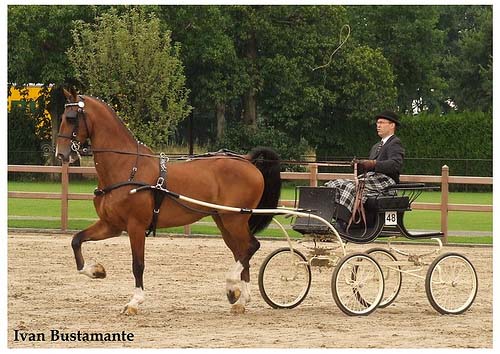
he Dutch Harness Horse belongs to the category of Warmbloods. These horses are also called Tuigpaard. These horses have been developed in their native Netherlands post the end of the Second World War. This breed has a thin population in comparison to the other horse breeds because it has only 40 sires and the brooding mares are less than 2000 in number. Most of these horses have made their way to America in recent years. These horses are easily recognizable, thanks to their distinct features.
The horses of the Dutch Harness breed have an expressive head that had a straight profile that is a prominent characteristic of the Warmblood horses. Like in a Saddlebred, the head of the Dutch Harness horse is not only dry and long, but also narrow. These horses have a high set neck. The powerful shoulders of this horse are long and uniform. They have a level croup and the tail is set high. These features help us easily distinguish this horse. These horses have a long back and a wide loin region. The hind legs and forelegs of these horses are able to work independently because the croup is flat. The forelegs of this horse are longer than the hind legs which is the reason the horses seem to rise in the front but sink at the back.
The horses of the Dutch Harness Horse breed have a reactive nature and are very courageous. At the same time, these horses are also pleasant creatures and gentle and kind.
Colours
The most common coat colors of the Dutch Harness Horse are brown, black, chestnut and bay. The other coat colors that are not as common as these but are acceptable are shades of cream, true roan and gray.
Suitable for
These horses are mainly used for show harnessing competitions. They also excel in combined driving. They are also extensively used for various equestrian games during the Olympics and also participate in dressage competitions. In modern times, these horses are also used for production of a more powerful horse by cross breeding the horses of this breed with the Arabian horses.
History
Netherlands takes pride in have a strong culture and tradition of breeding good driving horses. The horses that were bred during the later part of the 19th century and early 20th century were termed as luxury horses. The Gronigans and the Gelderlanders were two separate breeds of luxury horses on which the Dutch Harness Horse breeds are based.
In the year 1969, The Royal Warmblood Horse Studbook of Netherlands came into existence in order to promote and preserve this breed.
:max_bytes(150000):strip_icc():format(webp)/what-horses-eat-that-keep-them-healthy-1886504-FINAL-5ba8dd3746e0fb0025eb2cb4.png)
:max_bytes(150000):strip_icc():format(webp)/horse-eye-resized-56a4dbf03df78cf77284fe95.jpg)
:max_bytes(150000):strip_icc():format(webp)/Horse-grooming-GettyImages-495726400-5876f27d5f9b584db351222e.jpg)
:max_bytes(150000):strip_icc():format(webp)/close-up-of-hand-holding-parrot-705172843-5b52bc4ec9e77c0037b6e5a4.jpg)
:max_bytes(150000):strip_icc():format(webp)/GettyImages-579524112-5c77331146e0fb000140a3a6.jpg)
:max_bytes(150000):strip_icc():format(webp)/budgerigarsonrope-331834_1920-5b628213c9e77c00255b32bc.jpg)
:max_bytes(150000):strip_icc():format(webp)/GettyImages-106887241-58325bc03df78c6f6a9a2ed2.jpg)
:max_bytes(150000):strip_icc():format(webp)/GettyImages-878015800-06106157c9d34a2081db4abcae8699b1.jpg)
:max_bytes(150000):strip_icc():format(webp)/hungry-cat-57b72fac5f9b58cdfda11a62.jpg)


:max_bytes(150000):strip_icc():format(webp)/4374985466_59c7f6545b_o-8b4f24f2f3e544349fe537fde58cfad0.jpg)
:max_bytes(150000):strip_icc():format(webp)/GettyImages-9298737261-500c5a2fba4248f89d1c17a33bf438f7.jpg)
:max_bytes(150000):strip_icc():format(webp)/veterinarian-and-owners-examining-dog-in-vet-s-surgery-164853745-dbecbdb691d549d79487d84356920cf4.jpg)